Critical Analysis: Key Events and Structure of Air Transport
VerifiedAdded on 2023/06/18
|14
|3147
|343
Report
AI Summary
This report provides an overview of the air transport industry, focusing on 15 key events that have significantly shaped its development since 1903. Beginning with the use of balloons for military purposes and the Wright Brothers' first flight, the report traces the evolution of air transport through milestones such as the Paris Convention of 1919, the Madrid and Havana conventions, and the pivotal Chicago Convention, which established the International Civil Aviation Organization and defined the Freedoms of the Air. The report also examines the impact of economic regulations, the introduction of iconic aircraft like the Boeing 747 and Airbus A380, and the challenges faced by the Concorde. Each event is analyzed for its contribution to the structure, operations, and economic landscape of the air transport industry, providing a comprehensive historical perspective.
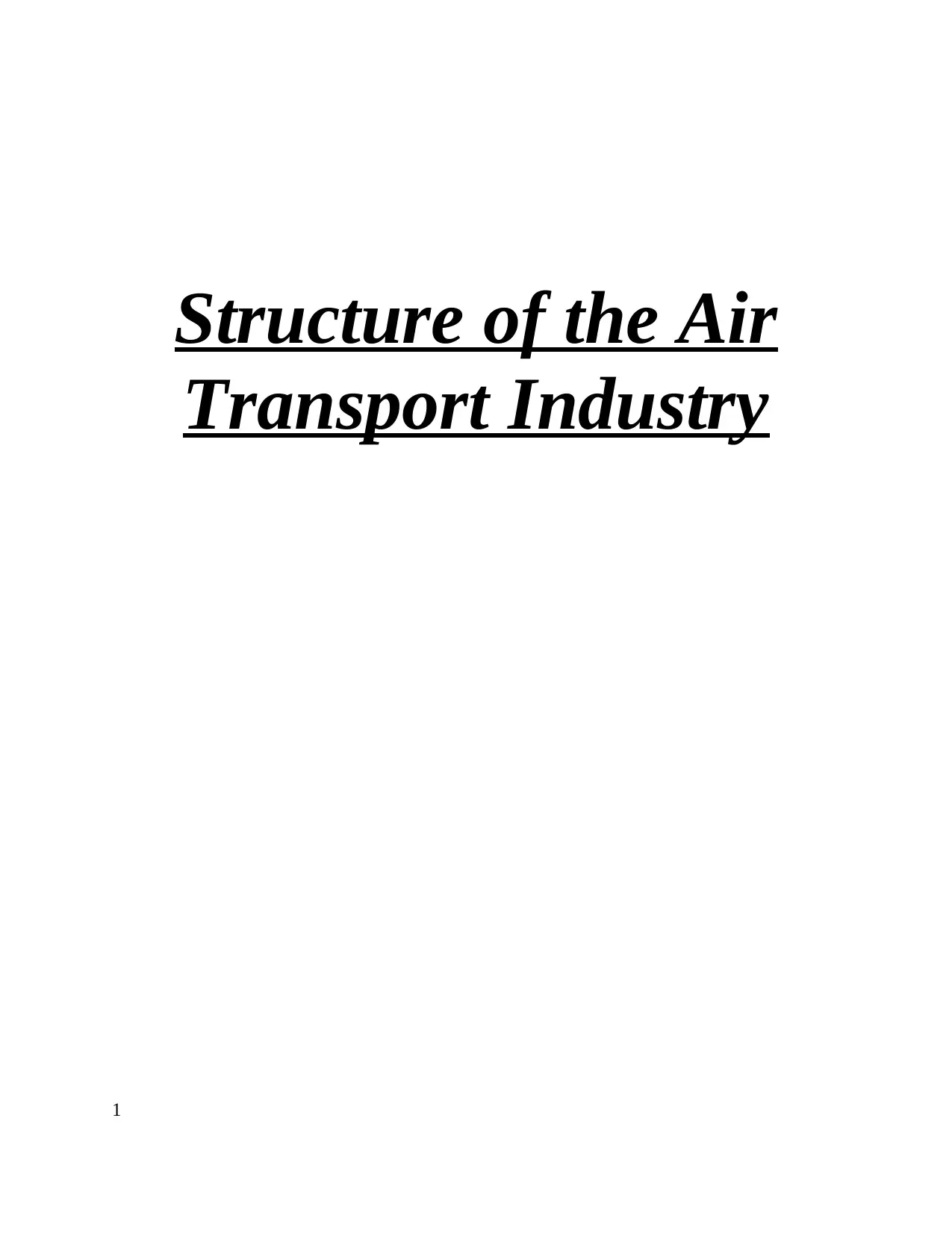
Structure of the Air
Transport Industry
1
Transport Industry
1
Secure Best Marks with AI Grader
Need help grading? Try our AI Grader for instant feedback on your assignments.
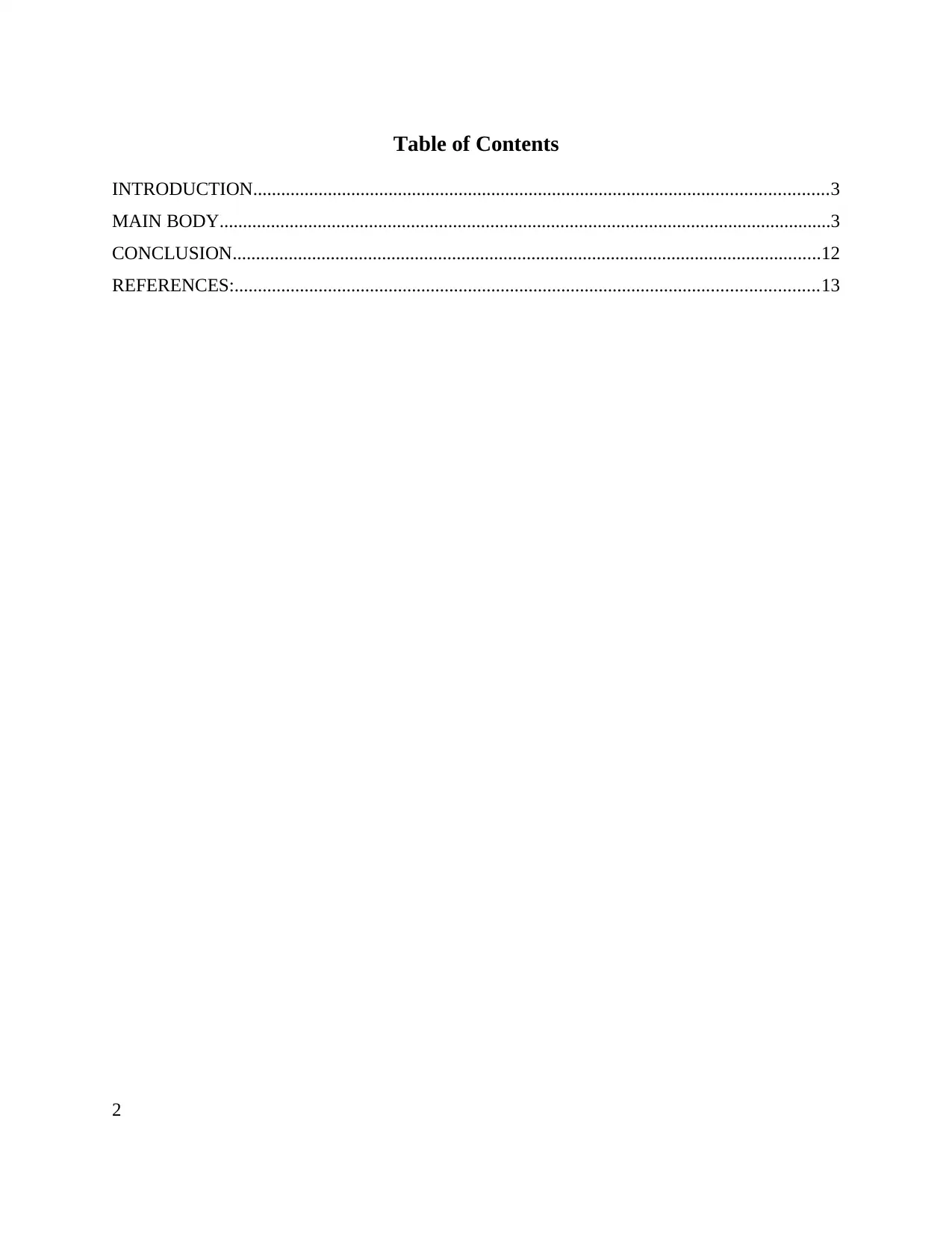
Table of Contents
INTRODUCTION...........................................................................................................................3
MAIN BODY...................................................................................................................................3
CONCLUSION..............................................................................................................................12
REFERENCES:.............................................................................................................................13
2
INTRODUCTION...........................................................................................................................3
MAIN BODY...................................................................................................................................3
CONCLUSION..............................................................................................................................12
REFERENCES:.............................................................................................................................13
2
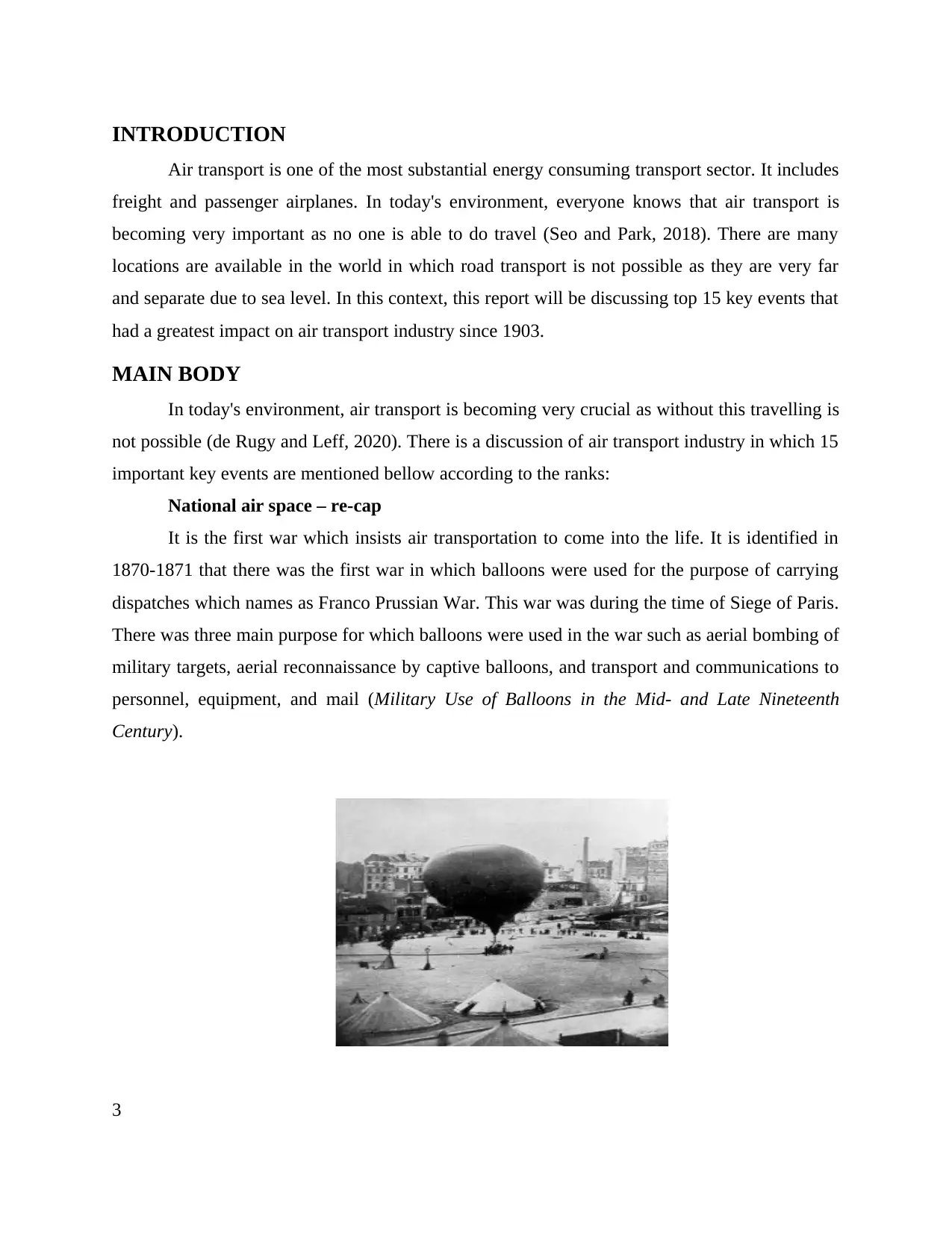
INTRODUCTION
Air transport is one of the most substantial energy consuming transport sector. It includes
freight and passenger airplanes. In today's environment, everyone knows that air transport is
becoming very important as no one is able to do travel (Seo and Park, 2018). There are many
locations are available in the world in which road transport is not possible as they are very far
and separate due to sea level. In this context, this report will be discussing top 15 key events that
had a greatest impact on air transport industry since 1903.
MAIN BODY
In today's environment, air transport is becoming very crucial as without this travelling is
not possible (de Rugy and Leff, 2020). There is a discussion of air transport industry in which 15
important key events are mentioned bellow according to the ranks:
National air space – re-cap
It is the first war which insists air transportation to come into the life. It is identified in
1870-1871 that there was the first war in which balloons were used for the purpose of carrying
dispatches which names as Franco Prussian War. This war was during the time of Siege of Paris.
There was three main purpose for which balloons were used in the war such as aerial bombing of
military targets, aerial reconnaissance by captive balloons, and transport and communications to
personnel, equipment, and mail (Military Use of Balloons in the Mid- and Late Nineteenth
Century).
3
Air transport is one of the most substantial energy consuming transport sector. It includes
freight and passenger airplanes. In today's environment, everyone knows that air transport is
becoming very important as no one is able to do travel (Seo and Park, 2018). There are many
locations are available in the world in which road transport is not possible as they are very far
and separate due to sea level. In this context, this report will be discussing top 15 key events that
had a greatest impact on air transport industry since 1903.
MAIN BODY
In today's environment, air transport is becoming very crucial as without this travelling is
not possible (de Rugy and Leff, 2020). There is a discussion of air transport industry in which 15
important key events are mentioned bellow according to the ranks:
National air space – re-cap
It is the first war which insists air transportation to come into the life. It is identified in
1870-1871 that there was the first war in which balloons were used for the purpose of carrying
dispatches which names as Franco Prussian War. This war was during the time of Siege of Paris.
There was three main purpose for which balloons were used in the war such as aerial bombing of
military targets, aerial reconnaissance by captive balloons, and transport and communications to
personnel, equipment, and mail (Military Use of Balloons in the Mid- and Late Nineteenth
Century).
3
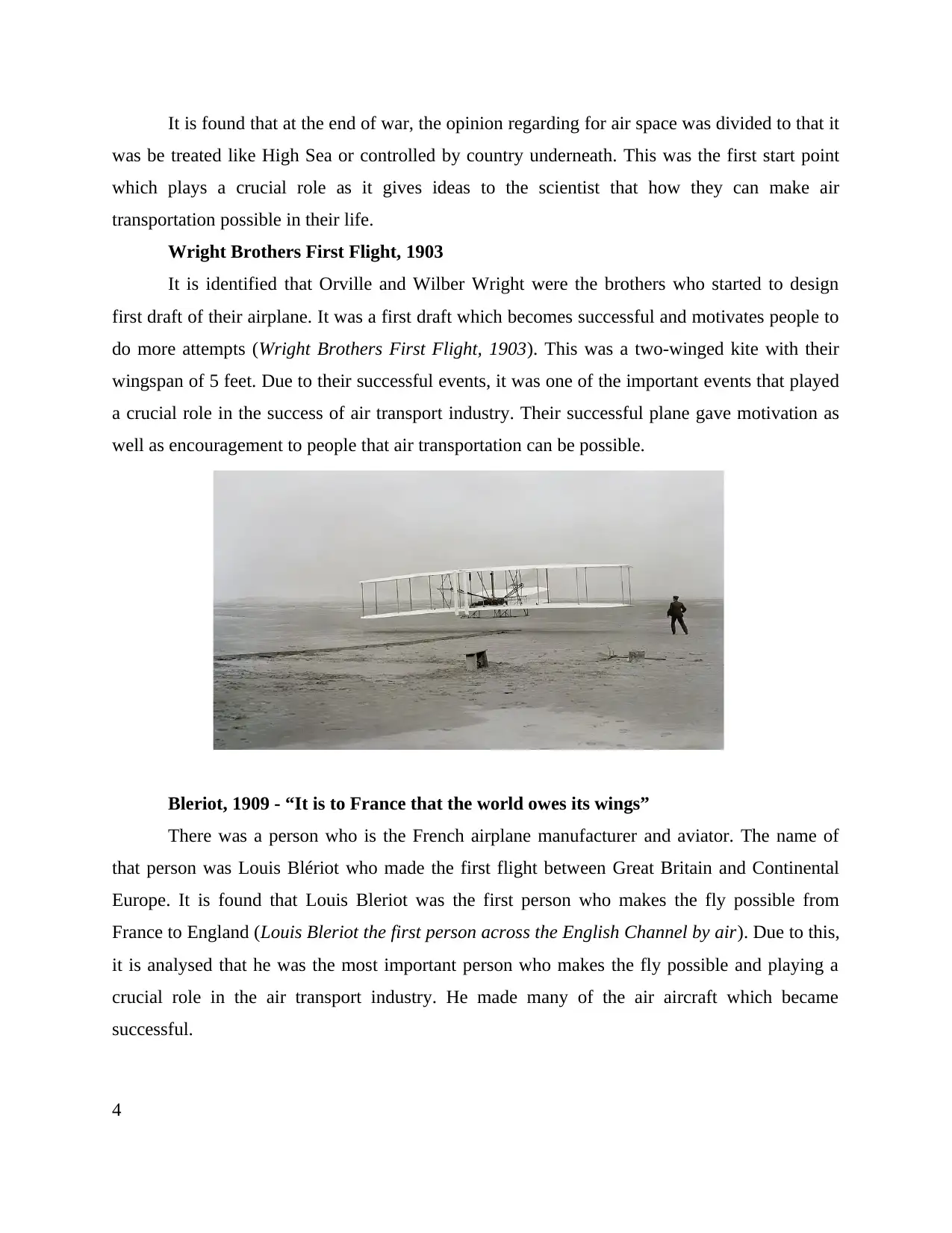
It is found that at the end of war, the opinion regarding for air space was divided to that it
was be treated like High Sea or controlled by country underneath. This was the first start point
which plays a crucial role as it gives ideas to the scientist that how they can make air
transportation possible in their life.
Wright Brothers First Flight, 1903
It is identified that Orville and Wilber Wright were the brothers who started to design
first draft of their airplane. It was a first draft which becomes successful and motivates people to
do more attempts (Wright Brothers First Flight, 1903). This was a two-winged kite with their
wingspan of 5 feet. Due to their successful events, it was one of the important events that played
a crucial role in the success of air transport industry. Their successful plane gave motivation as
well as encouragement to people that air transportation can be possible.
Bleriot, 1909 - “It is to France that the world owes its wings”
There was a person who is the French airplane manufacturer and aviator. The name of
that person was Louis Blériot who made the first flight between Great Britain and Continental
Europe. It is found that Louis Bleriot was the first person who makes the fly possible from
France to England (Louis Bleriot the first person across the English Channel by air). Due to this,
it is analysed that he was the most important person who makes the fly possible and playing a
crucial role in the air transport industry. He made many of the air aircraft which became
successful.
4
was be treated like High Sea or controlled by country underneath. This was the first start point
which plays a crucial role as it gives ideas to the scientist that how they can make air
transportation possible in their life.
Wright Brothers First Flight, 1903
It is identified that Orville and Wilber Wright were the brothers who started to design
first draft of their airplane. It was a first draft which becomes successful and motivates people to
do more attempts (Wright Brothers First Flight, 1903). This was a two-winged kite with their
wingspan of 5 feet. Due to their successful events, it was one of the important events that played
a crucial role in the success of air transport industry. Their successful plane gave motivation as
well as encouragement to people that air transportation can be possible.
Bleriot, 1909 - “It is to France that the world owes its wings”
There was a person who is the French airplane manufacturer and aviator. The name of
that person was Louis Blériot who made the first flight between Great Britain and Continental
Europe. It is found that Louis Bleriot was the first person who makes the fly possible from
France to England (Louis Bleriot the first person across the English Channel by air). Due to this,
it is analysed that he was the most important person who makes the fly possible and playing a
crucial role in the air transport industry. He made many of the air aircraft which became
successful.
4
Secure Best Marks with AI Grader
Need help grading? Try our AI Grader for instant feedback on your assignments.
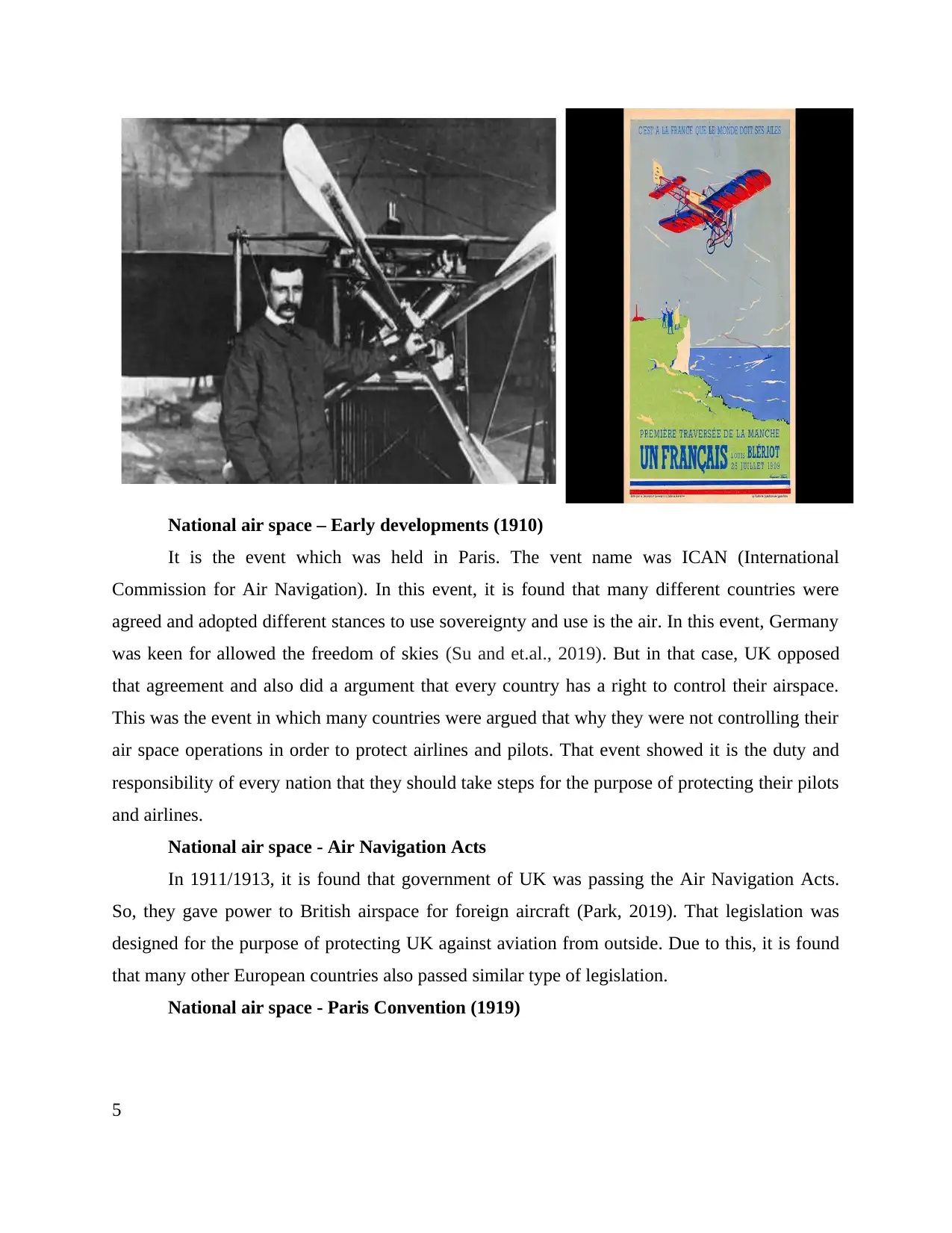
National air space – Early developments (1910)
It is the event which was held in Paris. The vent name was ICAN (International
Commission for Air Navigation). In this event, it is found that many different countries were
agreed and adopted different stances to use sovereignty and use is the air. In this event, Germany
was keen for allowed the freedom of skies (Su and et.al., 2019). But in that case, UK opposed
that agreement and also did a argument that every country has a right to control their airspace.
This was the event in which many countries were argued that why they were not controlling their
air space operations in order to protect airlines and pilots. That event showed it is the duty and
responsibility of every nation that they should take steps for the purpose of protecting their pilots
and airlines.
National air space - Air Navigation Acts
In 1911/1913, it is found that government of UK was passing the Air Navigation Acts.
So, they gave power to British airspace for foreign aircraft (Park, 2019). That legislation was
designed for the purpose of protecting UK against aviation from outside. Due to this, it is found
that many other European countries also passed similar type of legislation.
National air space - Paris Convention (1919)
5
It is the event which was held in Paris. The vent name was ICAN (International
Commission for Air Navigation). In this event, it is found that many different countries were
agreed and adopted different stances to use sovereignty and use is the air. In this event, Germany
was keen for allowed the freedom of skies (Su and et.al., 2019). But in that case, UK opposed
that agreement and also did a argument that every country has a right to control their airspace.
This was the event in which many countries were argued that why they were not controlling their
air space operations in order to protect airlines and pilots. That event showed it is the duty and
responsibility of every nation that they should take steps for the purpose of protecting their pilots
and airlines.
National air space - Air Navigation Acts
In 1911/1913, it is found that government of UK was passing the Air Navigation Acts.
So, they gave power to British airspace for foreign aircraft (Park, 2019). That legislation was
designed for the purpose of protecting UK against aviation from outside. Due to this, it is found
that many other European countries also passed similar type of legislation.
National air space - Paris Convention (1919)
5
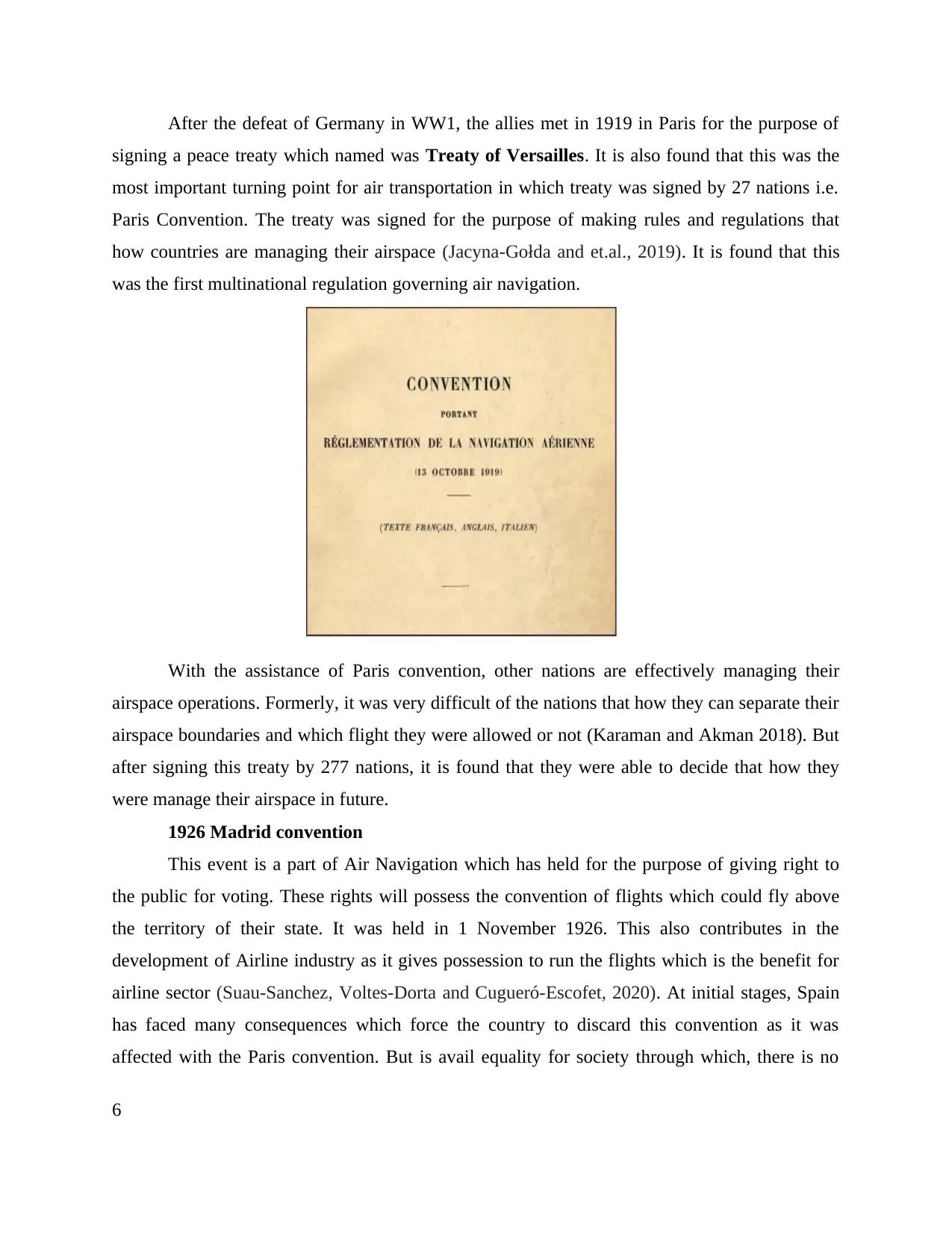
After the defeat of Germany in WW1, the allies met in 1919 in Paris for the purpose of
signing a peace treaty which named was Treaty of Versailles. It is also found that this was the
most important turning point for air transportation in which treaty was signed by 27 nations i.e.
Paris Convention. The treaty was signed for the purpose of making rules and regulations that
how countries are managing their airspace (Jacyna-Gołda and et.al., 2019). It is found that this
was the first multinational regulation governing air navigation.
With the assistance of Paris convention, other nations are effectively managing their
airspace operations. Formerly, it was very difficult of the nations that how they can separate their
airspace boundaries and which flight they were allowed or not (Karaman and Akman 2018). But
after signing this treaty by 277 nations, it is found that they were able to decide that how they
were manage their airspace in future.
1926 Madrid convention
This event is a part of Air Navigation which has held for the purpose of giving right to
the public for voting. These rights will possess the convention of flights which could fly above
the territory of their state. It was held in 1 November 1926. This also contributes in the
development of Airline industry as it gives possession to run the flights which is the benefit for
airline sector (Suau-Sanchez, Voltes-Dorta and Cugueró-Escofet, 2020). At initial stages, Spain
has faced many consequences which force the country to discard this convention as it was
affected with the Paris convention. But is avail equality for society through which, there is no
6
signing a peace treaty which named was Treaty of Versailles. It is also found that this was the
most important turning point for air transportation in which treaty was signed by 27 nations i.e.
Paris Convention. The treaty was signed for the purpose of making rules and regulations that
how countries are managing their airspace (Jacyna-Gołda and et.al., 2019). It is found that this
was the first multinational regulation governing air navigation.
With the assistance of Paris convention, other nations are effectively managing their
airspace operations. Formerly, it was very difficult of the nations that how they can separate their
airspace boundaries and which flight they were allowed or not (Karaman and Akman 2018). But
after signing this treaty by 277 nations, it is found that they were able to decide that how they
were manage their airspace in future.
1926 Madrid convention
This event is a part of Air Navigation which has held for the purpose of giving right to
the public for voting. These rights will possess the convention of flights which could fly above
the territory of their state. It was held in 1 November 1926. This also contributes in the
development of Airline industry as it gives possession to run the flights which is the benefit for
airline sector (Suau-Sanchez, Voltes-Dorta and Cugueró-Escofet, 2020). At initial stages, Spain
has faced many consequences which force the country to discard this convention as it was
affected with the Paris convention. But is avail equality for society through which, there is no
6
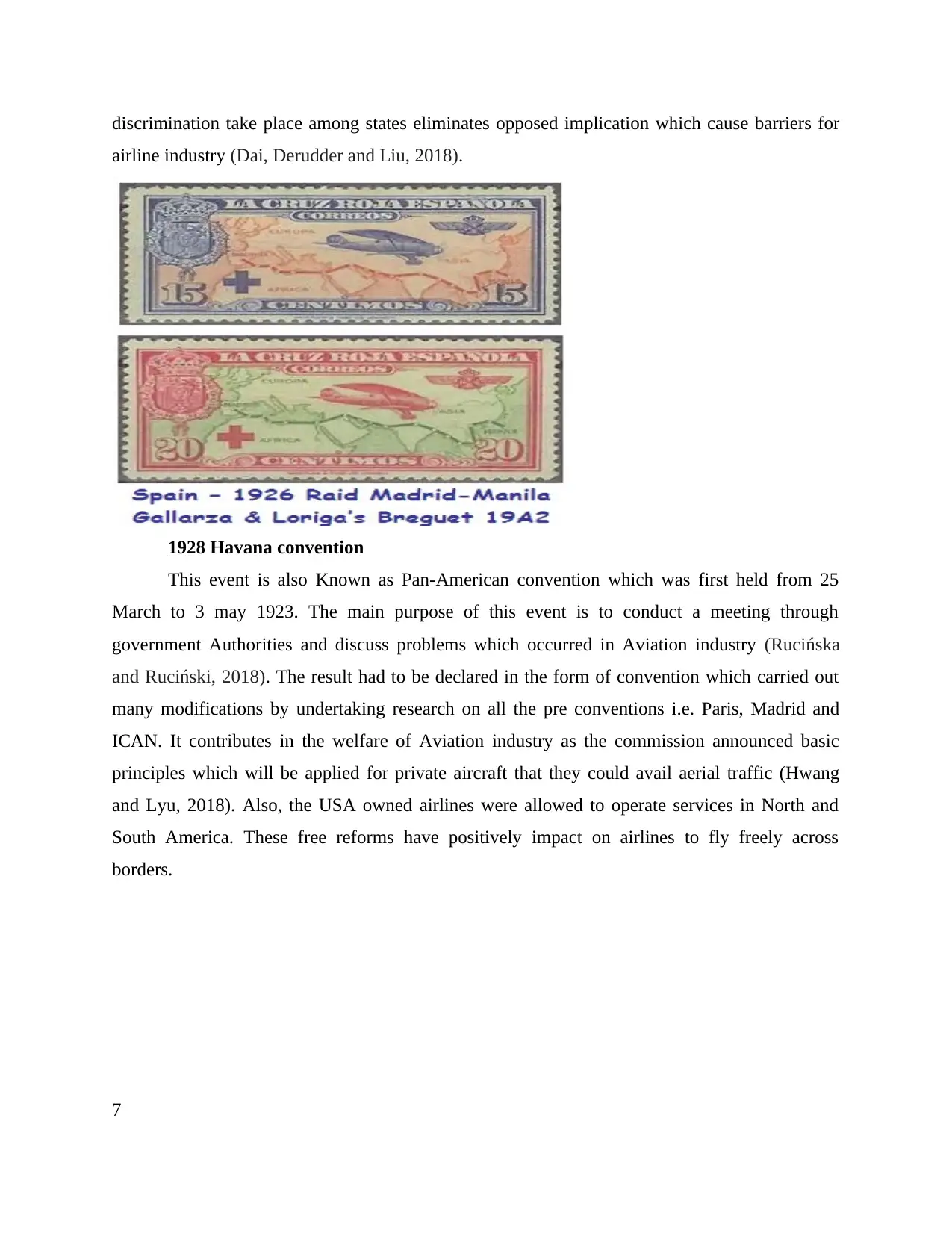
discrimination take place among states eliminates opposed implication which cause barriers for
airline industry (Dai, Derudder and Liu, 2018).
1928 Havana convention
This event is also Known as Pan-American convention which was first held from 25
March to 3 may 1923. The main purpose of this event is to conduct a meeting through
government Authorities and discuss problems which occurred in Aviation industry (Rucińska
and Ruciński, 2018). The result had to be declared in the form of convention which carried out
many modifications by undertaking research on all the pre conventions i.e. Paris, Madrid and
ICAN. It contributes in the welfare of Aviation industry as the commission announced basic
principles which will be applied for private aircraft that they could avail aerial traffic (Hwang
and Lyu, 2018). Also, the USA owned airlines were allowed to operate services in North and
South America. These free reforms have positively impact on airlines to fly freely across
borders.
7
airline industry (Dai, Derudder and Liu, 2018).
1928 Havana convention
This event is also Known as Pan-American convention which was first held from 25
March to 3 may 1923. The main purpose of this event is to conduct a meeting through
government Authorities and discuss problems which occurred in Aviation industry (Rucińska
and Ruciński, 2018). The result had to be declared in the form of convention which carried out
many modifications by undertaking research on all the pre conventions i.e. Paris, Madrid and
ICAN. It contributes in the welfare of Aviation industry as the commission announced basic
principles which will be applied for private aircraft that they could avail aerial traffic (Hwang
and Lyu, 2018). Also, the USA owned airlines were allowed to operate services in North and
South America. These free reforms have positively impact on airlines to fly freely across
borders.
7
Paraphrase This Document
Need a fresh take? Get an instant paraphrase of this document with our AI Paraphraser
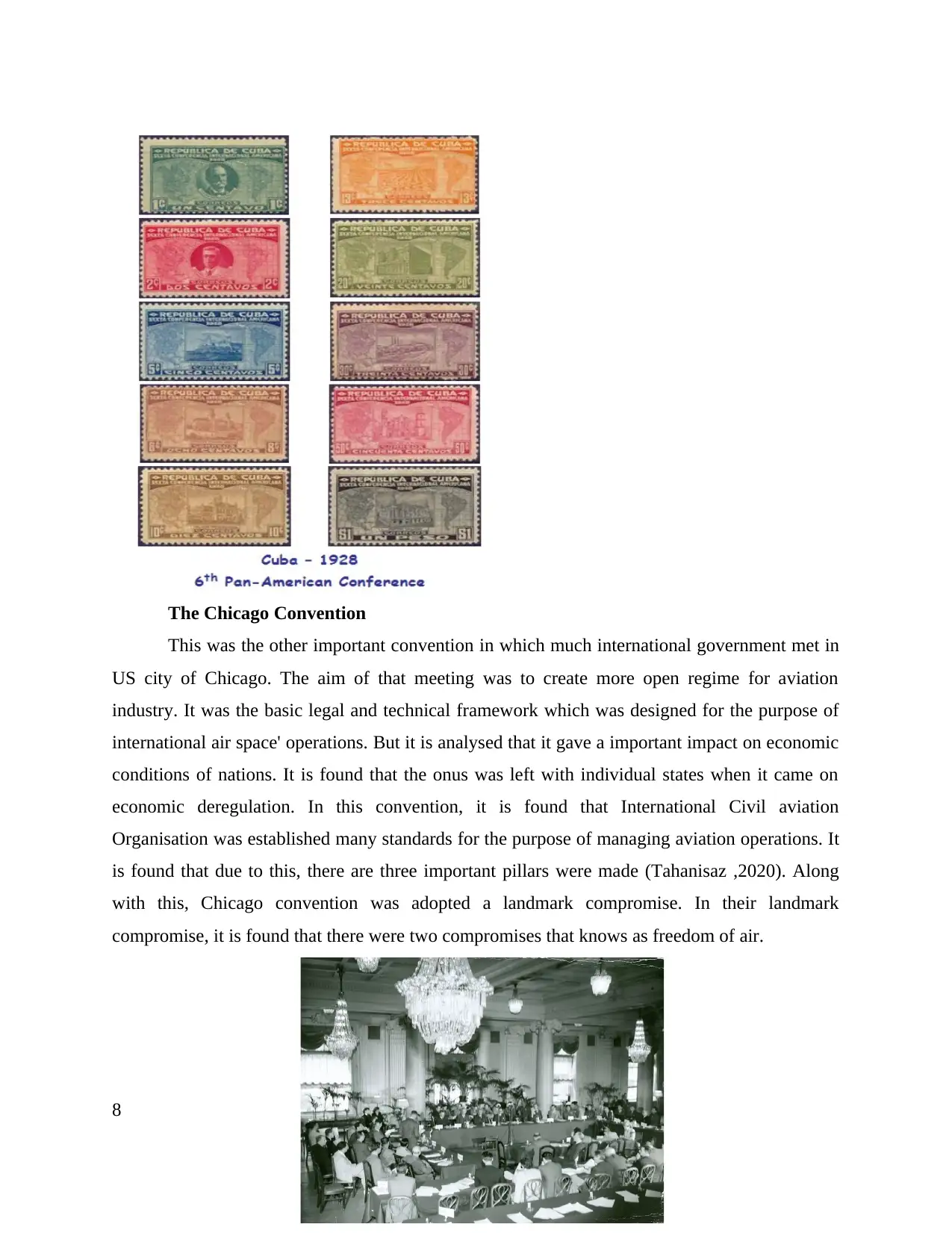
The Chicago Convention
This was the other important convention in which much international government met in
US city of Chicago. The aim of that meeting was to create more open regime for aviation
industry. It was the basic legal and technical framework which was designed for the purpose of
international air space' operations. But it is analysed that it gave a important impact on economic
conditions of nations. It is found that the onus was left with individual states when it came on
economic deregulation. In this convention, it is found that International Civil aviation
Organisation was established many standards for the purpose of managing aviation operations. It
is found that due to this, there are three important pillars were made (Tahanisaz ,2020). Along
with this, Chicago convention was adopted a landmark compromise. In their landmark
compromise, it is found that there were two compromises that knows as freedom of air.
8
This was the other important convention in which much international government met in
US city of Chicago. The aim of that meeting was to create more open regime for aviation
industry. It was the basic legal and technical framework which was designed for the purpose of
international air space' operations. But it is analysed that it gave a important impact on economic
conditions of nations. It is found that the onus was left with individual states when it came on
economic deregulation. In this convention, it is found that International Civil aviation
Organisation was established many standards for the purpose of managing aviation operations. It
is found that due to this, there are three important pillars were made (Tahanisaz ,2020). Along
with this, Chicago convention was adopted a landmark compromise. In their landmark
compromise, it is found that there were two compromises that knows as freedom of air.
8
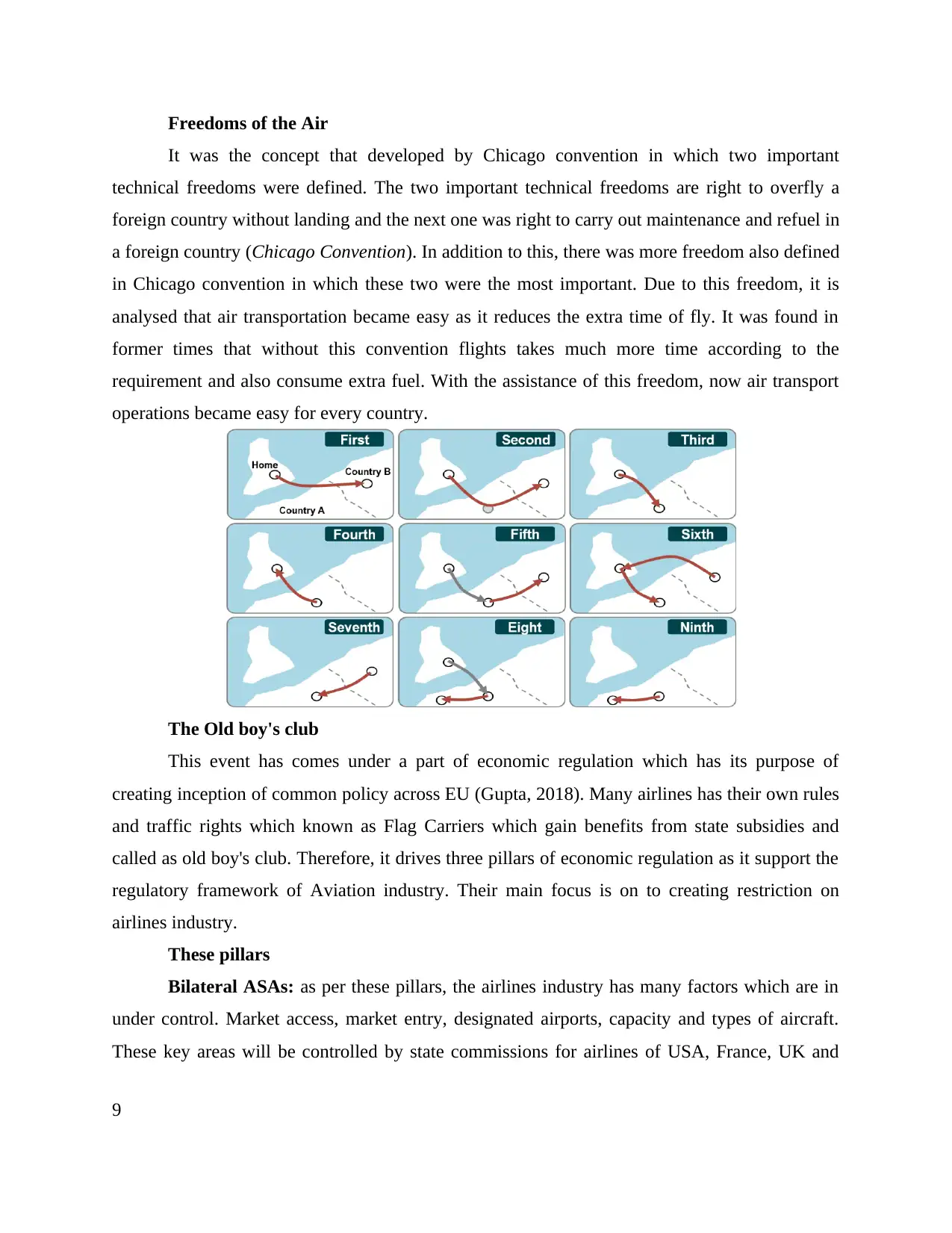
Freedoms of the Air
It was the concept that developed by Chicago convention in which two important
technical freedoms were defined. The two important technical freedoms are right to overfly a
foreign country without landing and the next one was right to carry out maintenance and refuel in
a foreign country (Chicago Convention). In addition to this, there was more freedom also defined
in Chicago convention in which these two were the most important. Due to this freedom, it is
analysed that air transportation became easy as it reduces the extra time of fly. It was found in
former times that without this convention flights takes much more time according to the
requirement and also consume extra fuel. With the assistance of this freedom, now air transport
operations became easy for every country.
The Old boy's club
This event has comes under a part of economic regulation which has its purpose of
creating inception of common policy across EU (Gupta, 2018). Many airlines has their own rules
and traffic rights which known as Flag Carriers which gain benefits from state subsidies and
called as old boy's club. Therefore, it drives three pillars of economic regulation as it support the
regulatory framework of Aviation industry. Their main focus is on to creating restriction on
airlines industry.
These pillars
Bilateral ASAs: as per these pillars, the airlines industry has many factors which are in
under control. Market access, market entry, designated airports, capacity and types of aircraft.
These key areas will be controlled by state commissions for airlines of USA, France, UK and
9
It was the concept that developed by Chicago convention in which two important
technical freedoms were defined. The two important technical freedoms are right to overfly a
foreign country without landing and the next one was right to carry out maintenance and refuel in
a foreign country (Chicago Convention). In addition to this, there was more freedom also defined
in Chicago convention in which these two were the most important. Due to this freedom, it is
analysed that air transportation became easy as it reduces the extra time of fly. It was found in
former times that without this convention flights takes much more time according to the
requirement and also consume extra fuel. With the assistance of this freedom, now air transport
operations became easy for every country.
The Old boy's club
This event has comes under a part of economic regulation which has its purpose of
creating inception of common policy across EU (Gupta, 2018). Many airlines has their own rules
and traffic rights which known as Flag Carriers which gain benefits from state subsidies and
called as old boy's club. Therefore, it drives three pillars of economic regulation as it support the
regulatory framework of Aviation industry. Their main focus is on to creating restriction on
airlines industry.
These pillars
Bilateral ASAs: as per these pillars, the airlines industry has many factors which are in
under control. Market access, market entry, designated airports, capacity and types of aircraft.
These key areas will be controlled by state commissions for airlines of USA, France, UK and
9
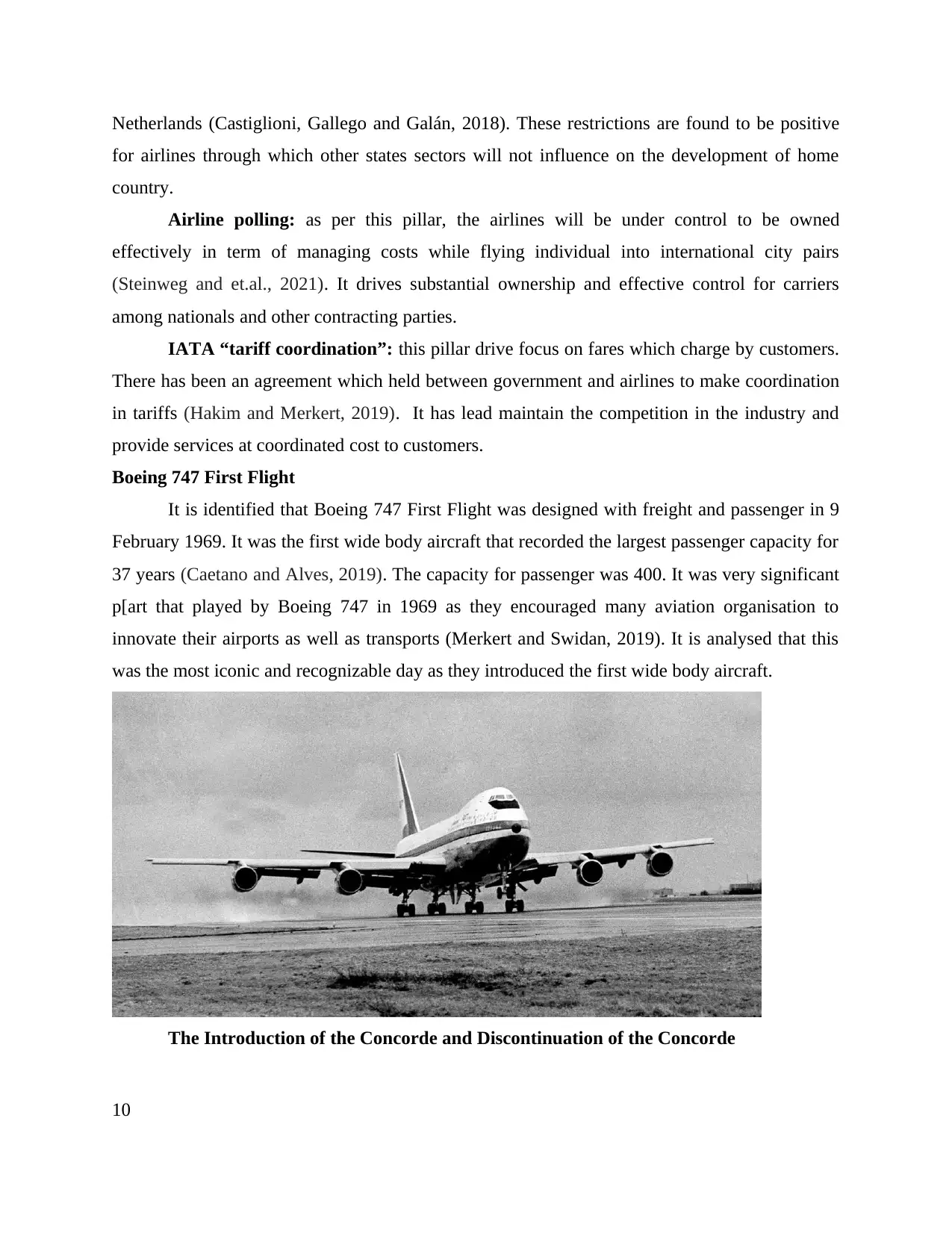
Netherlands (Castiglioni, Gallego and Galán, 2018). These restrictions are found to be positive
for airlines through which other states sectors will not influence on the development of home
country.
Airline polling: as per this pillar, the airlines will be under control to be owned
effectively in term of managing costs while flying individual into international city pairs
(Steinweg and et.al., 2021). It drives substantial ownership and effective control for carriers
among nationals and other contracting parties.
IATA “tariff coordination”: this pillar drive focus on fares which charge by customers.
There has been an agreement which held between government and airlines to make coordination
in tariffs (Hakim and Merkert, 2019). It has lead maintain the competition in the industry and
provide services at coordinated cost to customers.
Boeing 747 First Flight
It is identified that Boeing 747 First Flight was designed with freight and passenger in 9
February 1969. It was the first wide body aircraft that recorded the largest passenger capacity for
37 years (Caetano and Alves, 2019). The capacity for passenger was 400. It was very significant
p[art that played by Boeing 747 in 1969 as they encouraged many aviation organisation to
innovate their airports as well as transports (Merkert and Swidan, 2019). It is analysed that this
was the most iconic and recognizable day as they introduced the first wide body aircraft.
The Introduction of the Concorde and Discontinuation of the Concorde
10
for airlines through which other states sectors will not influence on the development of home
country.
Airline polling: as per this pillar, the airlines will be under control to be owned
effectively in term of managing costs while flying individual into international city pairs
(Steinweg and et.al., 2021). It drives substantial ownership and effective control for carriers
among nationals and other contracting parties.
IATA “tariff coordination”: this pillar drive focus on fares which charge by customers.
There has been an agreement which held between government and airlines to make coordination
in tariffs (Hakim and Merkert, 2019). It has lead maintain the competition in the industry and
provide services at coordinated cost to customers.
Boeing 747 First Flight
It is identified that Boeing 747 First Flight was designed with freight and passenger in 9
February 1969. It was the first wide body aircraft that recorded the largest passenger capacity for
37 years (Caetano and Alves, 2019). The capacity for passenger was 400. It was very significant
p[art that played by Boeing 747 in 1969 as they encouraged many aviation organisation to
innovate their airports as well as transports (Merkert and Swidan, 2019). It is analysed that this
was the most iconic and recognizable day as they introduced the first wide body aircraft.
The Introduction of the Concorde and Discontinuation of the Concorde
10
Secure Best Marks with AI Grader
Need help grading? Try our AI Grader for instant feedback on your assignments.
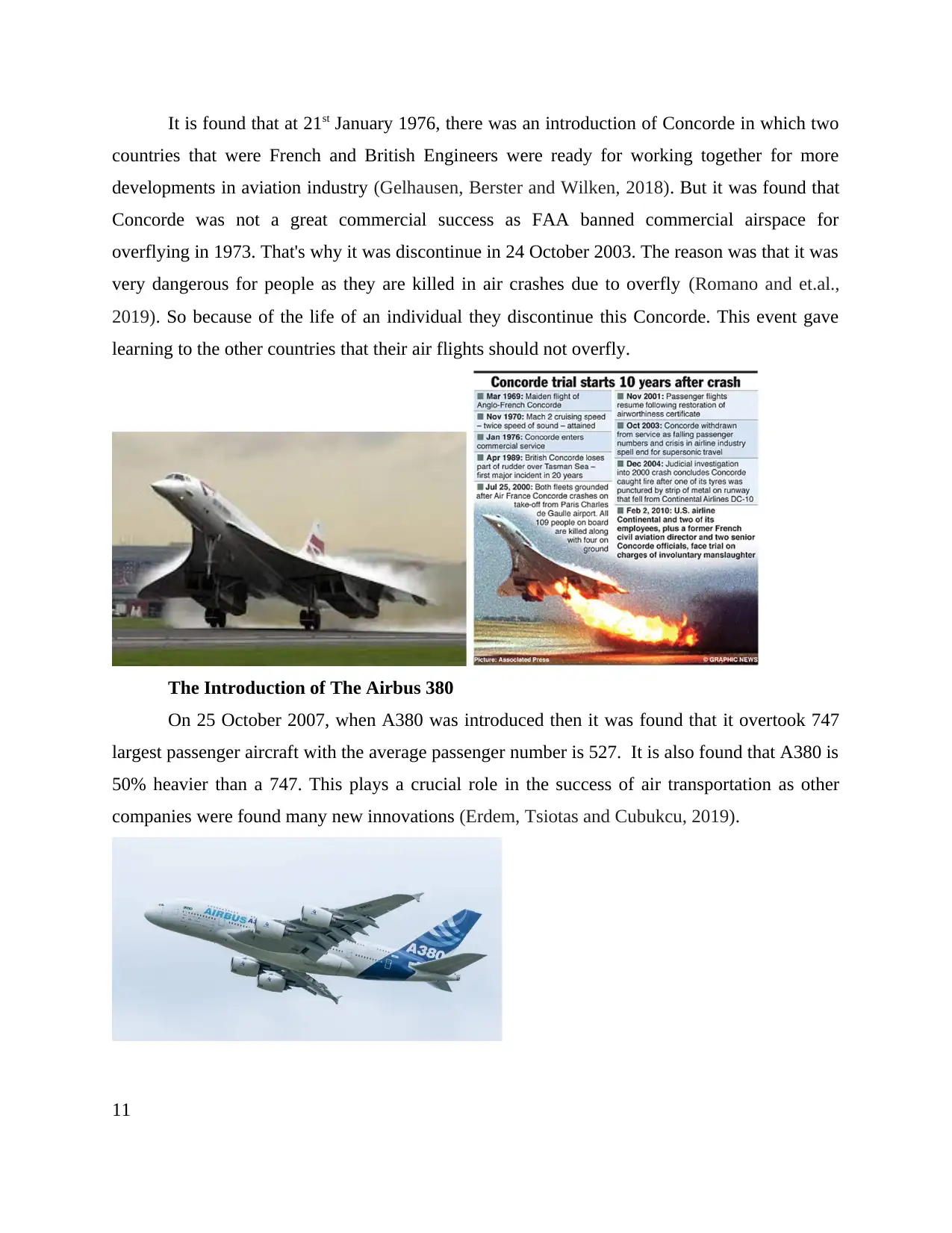
It is found that at 21st January 1976, there was an introduction of Concorde in which two
countries that were French and British Engineers were ready for working together for more
developments in aviation industry (Gelhausen, Berster and Wilken, 2018). But it was found that
Concorde was not a great commercial success as FAA banned commercial airspace for
overflying in 1973. That's why it was discontinue in 24 October 2003. The reason was that it was
very dangerous for people as they are killed in air crashes due to overfly (Romano and et.al.,
2019). So because of the life of an individual they discontinue this Concorde. This event gave
learning to the other countries that their air flights should not overfly.
The Introduction of The Airbus 380
On 25 October 2007, when A380 was introduced then it was found that it overtook 747
largest passenger aircraft with the average passenger number is 527. It is also found that A380 is
50% heavier than a 747. This plays a crucial role in the success of air transportation as other
companies were found many new innovations (Erdem, Tsiotas and Cubukcu, 2019).
11
countries that were French and British Engineers were ready for working together for more
developments in aviation industry (Gelhausen, Berster and Wilken, 2018). But it was found that
Concorde was not a great commercial success as FAA banned commercial airspace for
overflying in 1973. That's why it was discontinue in 24 October 2003. The reason was that it was
very dangerous for people as they are killed in air crashes due to overfly (Romano and et.al.,
2019). So because of the life of an individual they discontinue this Concorde. This event gave
learning to the other countries that their air flights should not overfly.
The Introduction of The Airbus 380
On 25 October 2007, when A380 was introduced then it was found that it overtook 747
largest passenger aircraft with the average passenger number is 527. It is also found that A380 is
50% heavier than a 747. This plays a crucial role in the success of air transportation as other
companies were found many new innovations (Erdem, Tsiotas and Cubukcu, 2019).
11

CONCLUSION
From the above discussion, it is analysed that there are top 15 key events discussed that
shows how air transport industry was developed. In addition to this, it is also analysed that there
is 71% water available in the land and due to this locations are separate from each other. This is
the main reason that air transport is very important for every individual.
12
From the above discussion, it is analysed that there are top 15 key events discussed that
shows how air transport industry was developed. In addition to this, it is also analysed that there
is 71% water available in the land and due to this locations are separate from each other. This is
the main reason that air transport is very important for every individual.
12
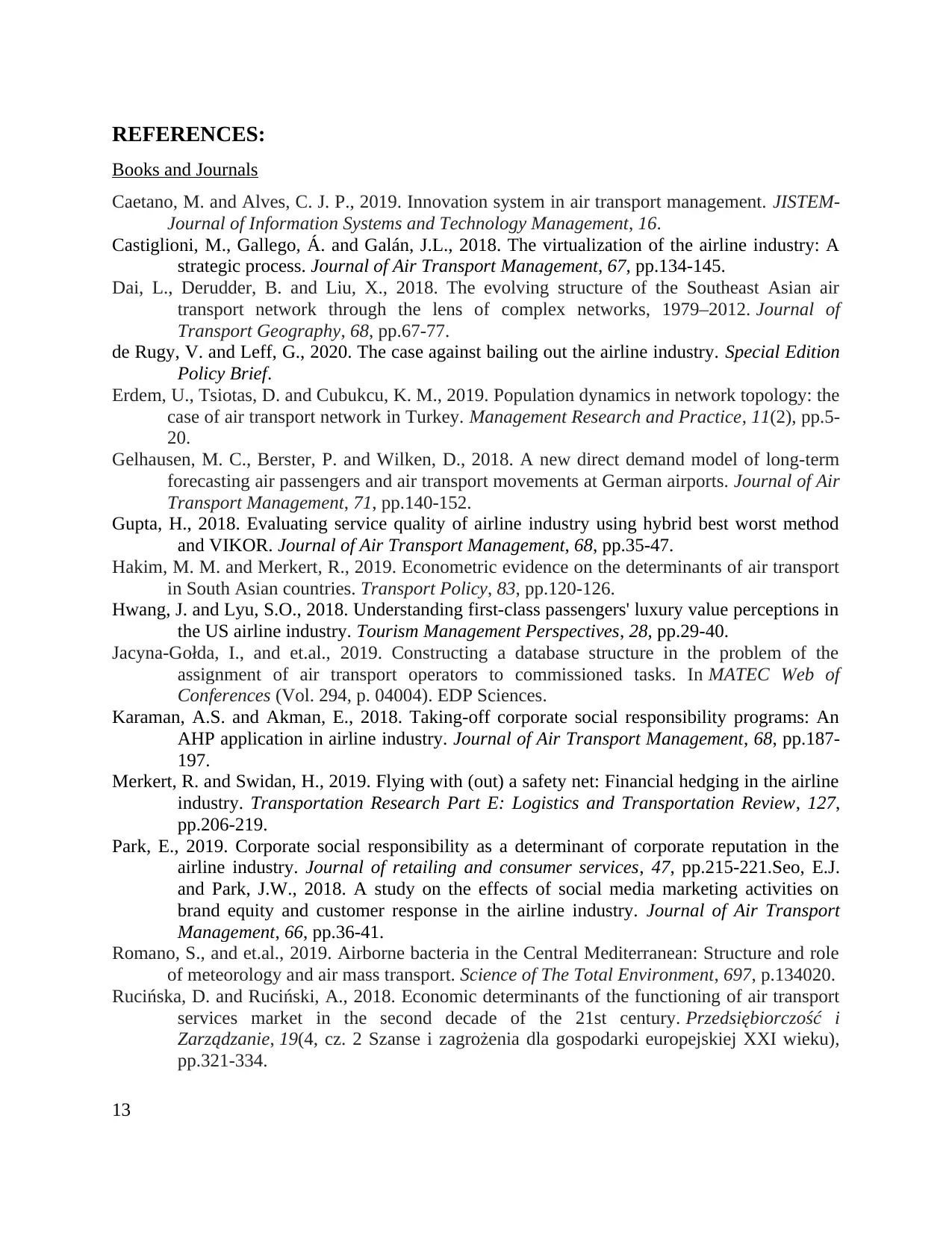
REFERENCES:
Books and Journals
Caetano, M. and Alves, C. J. P., 2019. Innovation system in air transport management. JISTEM-
Journal of Information Systems and Technology Management, 16.
Castiglioni, M., Gallego, Á. and Galán, J.L., 2018. The virtualization of the airline industry: A
strategic process. Journal of Air Transport Management, 67, pp.134-145.
Dai, L., Derudder, B. and Liu, X., 2018. The evolving structure of the Southeast Asian air
transport network through the lens of complex networks, 1979–2012. Journal of
Transport Geography, 68, pp.67-77.
de Rugy, V. and Leff, G., 2020. The case against bailing out the airline industry. Special Edition
Policy Brief.
Erdem, U., Tsiotas, D. and Cubukcu, K. M., 2019. Population dynamics in network topology: the
case of air transport network in Turkey. Management Research and Practice, 11(2), pp.5-
20.
Gelhausen, M. C., Berster, P. and Wilken, D., 2018. A new direct demand model of long-term
forecasting air passengers and air transport movements at German airports. Journal of Air
Transport Management, 71, pp.140-152.
Gupta, H., 2018. Evaluating service quality of airline industry using hybrid best worst method
and VIKOR. Journal of Air Transport Management, 68, pp.35-47.
Hakim, M. M. and Merkert, R., 2019. Econometric evidence on the determinants of air transport
in South Asian countries. Transport Policy, 83, pp.120-126.
Hwang, J. and Lyu, S.O., 2018. Understanding first-class passengers' luxury value perceptions in
the US airline industry. Tourism Management Perspectives, 28, pp.29-40.
Jacyna-Gołda, I., and et.al., 2019. Constructing a database structure in the problem of the
assignment of air transport operators to commissioned tasks. In MATEC Web of
Conferences (Vol. 294, p. 04004). EDP Sciences.
Karaman, A.S. and Akman, E., 2018. Taking-off corporate social responsibility programs: An
AHP application in airline industry. Journal of Air Transport Management, 68, pp.187-
197.
Merkert, R. and Swidan, H., 2019. Flying with (out) a safety net: Financial hedging in the airline
industry. Transportation Research Part E: Logistics and Transportation Review, 127,
pp.206-219.
Park, E., 2019. Corporate social responsibility as a determinant of corporate reputation in the
airline industry. Journal of retailing and consumer services, 47, pp.215-221.Seo, E.J.
and Park, J.W., 2018. A study on the effects of social media marketing activities on
brand equity and customer response in the airline industry. Journal of Air Transport
Management, 66, pp.36-41.
Romano, S., and et.al., 2019. Airborne bacteria in the Central Mediterranean: Structure and role
of meteorology and air mass transport. Science of The Total Environment, 697, p.134020.
Rucińska, D. and Ruciński, A., 2018. Economic determinants of the functioning of air transport
services market in the second decade of the 21st century. Przedsiębiorczość i
Zarządzanie, 19(4, cz. 2 Szanse i zagrożenia dla gospodarki europejskiej XXI wieku),
pp.321-334.
13
Books and Journals
Caetano, M. and Alves, C. J. P., 2019. Innovation system in air transport management. JISTEM-
Journal of Information Systems and Technology Management, 16.
Castiglioni, M., Gallego, Á. and Galán, J.L., 2018. The virtualization of the airline industry: A
strategic process. Journal of Air Transport Management, 67, pp.134-145.
Dai, L., Derudder, B. and Liu, X., 2018. The evolving structure of the Southeast Asian air
transport network through the lens of complex networks, 1979–2012. Journal of
Transport Geography, 68, pp.67-77.
de Rugy, V. and Leff, G., 2020. The case against bailing out the airline industry. Special Edition
Policy Brief.
Erdem, U., Tsiotas, D. and Cubukcu, K. M., 2019. Population dynamics in network topology: the
case of air transport network in Turkey. Management Research and Practice, 11(2), pp.5-
20.
Gelhausen, M. C., Berster, P. and Wilken, D., 2018. A new direct demand model of long-term
forecasting air passengers and air transport movements at German airports. Journal of Air
Transport Management, 71, pp.140-152.
Gupta, H., 2018. Evaluating service quality of airline industry using hybrid best worst method
and VIKOR. Journal of Air Transport Management, 68, pp.35-47.
Hakim, M. M. and Merkert, R., 2019. Econometric evidence on the determinants of air transport
in South Asian countries. Transport Policy, 83, pp.120-126.
Hwang, J. and Lyu, S.O., 2018. Understanding first-class passengers' luxury value perceptions in
the US airline industry. Tourism Management Perspectives, 28, pp.29-40.
Jacyna-Gołda, I., and et.al., 2019. Constructing a database structure in the problem of the
assignment of air transport operators to commissioned tasks. In MATEC Web of
Conferences (Vol. 294, p. 04004). EDP Sciences.
Karaman, A.S. and Akman, E., 2018. Taking-off corporate social responsibility programs: An
AHP application in airline industry. Journal of Air Transport Management, 68, pp.187-
197.
Merkert, R. and Swidan, H., 2019. Flying with (out) a safety net: Financial hedging in the airline
industry. Transportation Research Part E: Logistics and Transportation Review, 127,
pp.206-219.
Park, E., 2019. Corporate social responsibility as a determinant of corporate reputation in the
airline industry. Journal of retailing and consumer services, 47, pp.215-221.Seo, E.J.
and Park, J.W., 2018. A study on the effects of social media marketing activities on
brand equity and customer response in the airline industry. Journal of Air Transport
Management, 66, pp.36-41.
Romano, S., and et.al., 2019. Airborne bacteria in the Central Mediterranean: Structure and role
of meteorology and air mass transport. Science of The Total Environment, 697, p.134020.
Rucińska, D. and Ruciński, A., 2018. Economic determinants of the functioning of air transport
services market in the second decade of the 21st century. Przedsiębiorczość i
Zarządzanie, 19(4, cz. 2 Szanse i zagrożenia dla gospodarki europejskiej XXI wieku),
pp.321-334.
13
Paraphrase This Document
Need a fresh take? Get an instant paraphrase of this document with our AI Paraphraser
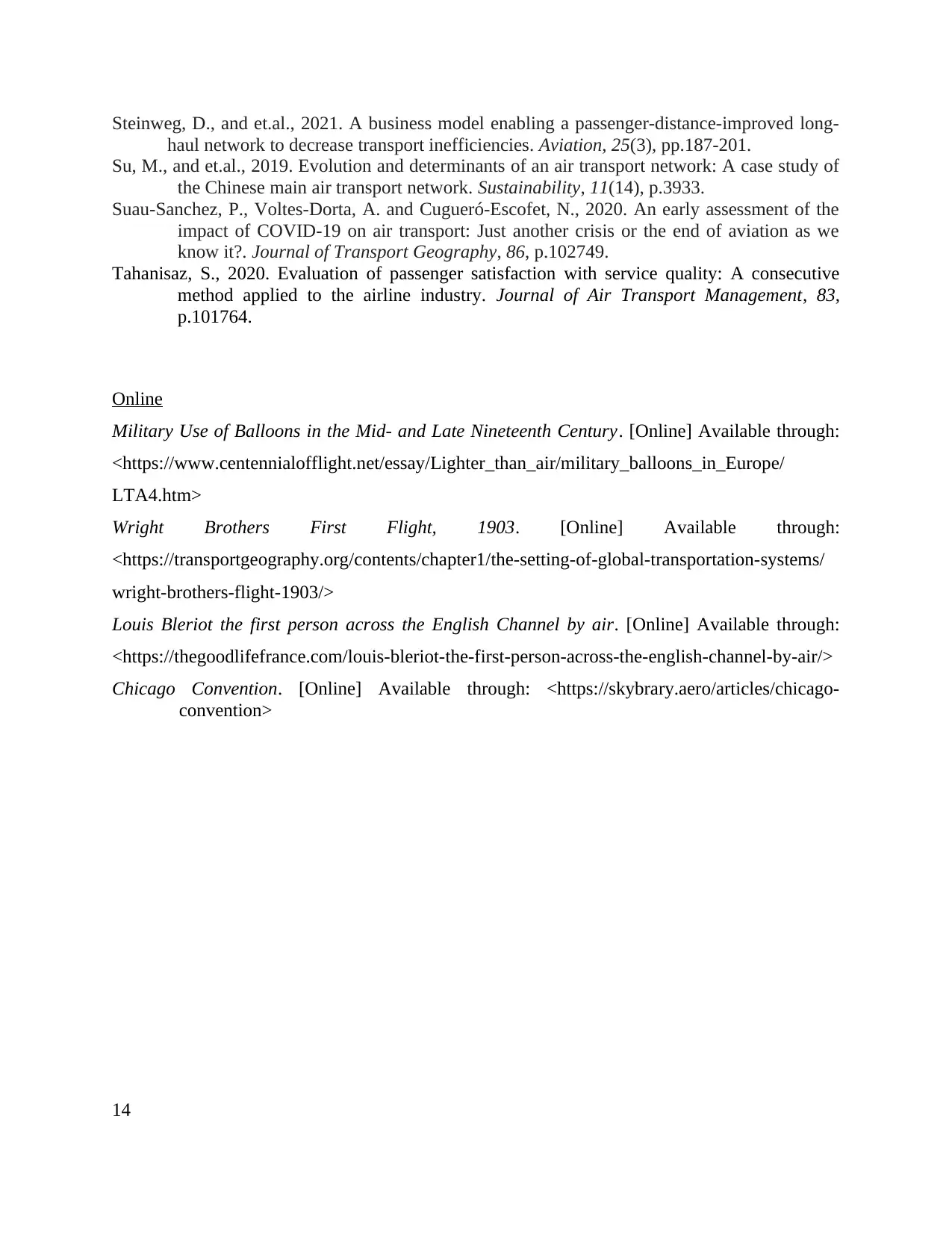
Steinweg, D., and et.al., 2021. A business model enabling a passenger-distance-improved long-
haul network to decrease transport inefficiencies. Aviation, 25(3), pp.187-201.
Su, M., and et.al., 2019. Evolution and determinants of an air transport network: A case study of
the Chinese main air transport network. Sustainability, 11(14), p.3933.
Suau-Sanchez, P., Voltes-Dorta, A. and Cugueró-Escofet, N., 2020. An early assessment of the
impact of COVID-19 on air transport: Just another crisis or the end of aviation as we
know it?. Journal of Transport Geography, 86, p.102749.
Tahanisaz, S., 2020. Evaluation of passenger satisfaction with service quality: A consecutive
method applied to the airline industry. Journal of Air Transport Management, 83,
p.101764.
Online
Military Use of Balloons in the Mid- and Late Nineteenth Century. [Online] Available through:
<https://www.centennialofflight.net/essay/Lighter_than_air/military_balloons_in_Europe/
LTA4.htm>
Wright Brothers First Flight, 1903. [Online] Available through:
<https://transportgeography.org/contents/chapter1/the-setting-of-global-transportation-systems/
wright-brothers-flight-1903/>
Louis Bleriot the first person across the English Channel by air. [Online] Available through:
<https://thegoodlifefrance.com/louis-bleriot-the-first-person-across-the-english-channel-by-air/>
Chicago Convention. [Online] Available through: <https://skybrary.aero/articles/chicago-
convention>
14
haul network to decrease transport inefficiencies. Aviation, 25(3), pp.187-201.
Su, M., and et.al., 2019. Evolution and determinants of an air transport network: A case study of
the Chinese main air transport network. Sustainability, 11(14), p.3933.
Suau-Sanchez, P., Voltes-Dorta, A. and Cugueró-Escofet, N., 2020. An early assessment of the
impact of COVID-19 on air transport: Just another crisis or the end of aviation as we
know it?. Journal of Transport Geography, 86, p.102749.
Tahanisaz, S., 2020. Evaluation of passenger satisfaction with service quality: A consecutive
method applied to the airline industry. Journal of Air Transport Management, 83,
p.101764.
Online
Military Use of Balloons in the Mid- and Late Nineteenth Century. [Online] Available through:
<https://www.centennialofflight.net/essay/Lighter_than_air/military_balloons_in_Europe/
LTA4.htm>
Wright Brothers First Flight, 1903. [Online] Available through:
<https://transportgeography.org/contents/chapter1/the-setting-of-global-transportation-systems/
wright-brothers-flight-1903/>
Louis Bleriot the first person across the English Channel by air. [Online] Available through:
<https://thegoodlifefrance.com/louis-bleriot-the-first-person-across-the-english-channel-by-air/>
Chicago Convention. [Online] Available through: <https://skybrary.aero/articles/chicago-
convention>
14
1 out of 14
Your All-in-One AI-Powered Toolkit for Academic Success.
+13062052269
info@desklib.com
Available 24*7 on WhatsApp / Email
![[object Object]](/_next/static/media/star-bottom.7253800d.svg)
Unlock your academic potential
© 2024 | Zucol Services PVT LTD | All rights reserved.


